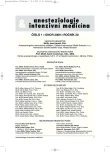Robot-assisted laparoscopic surgery from the anaesthesiologist’s perspective
Authors:
Jurenka Božetěch 1; Lásziková Eva 1; Köhler Otto 2; Langer Daniel 3; Balcárek Lukáš 1; Henlín Tomáš 1; Netuková Daniela 1; Ryska Miroslav 3
Authors‘ workplace:
Anesteziologicko-resuscitační oddělení ÚVN Praha
1; Urologické oddělení ÚVN Praha
2; Chirurgická klinika 2. LF UK Praha a ÚVN Praha
3
Published in:
Anest. intenziv. Med., 20, 2009, č. 1, s. 8-12
Category:
Anaesthesiology - Review Article
Overview
Robot-assisted laparoscopic surgery is a new and rapidly developing technology of the last decade. The surgeon takes advantage of the 3D surgical field imaging and manipulation scope beyond the capability of the current laparoscopic instruments. An uncomplicated course of robotic surgery significantly shortens the length of hospital stay compared to standard open surgery. On the other hand a robotic surgical system carries high acquisition and operating costs.
It remains to be seen whether robot-assisted surgical procedures are safe and minimal-invasive even in patients with multiple comorbidities.
Keywords:
Da Vinci Robotic Surgical System® – pathophysiology – perioperative stress – anaesthetic management – postoperative care – minimal invasive
Sources
1. Larsen, J. F., Svendsen, F. M., Pedersen, V. Randomized clinical trial of the effect of pneumoperitoneum on cardiac function and haemodynamics during laparoscopic cholecystectomy. British Journal of Surgery, 2004, 91, 7, p. 848–854.
2. Falabella, A., Moore-Jeffries, E., Sullivan, M. J., Nelson, R., Lew, M. Cardiac function during steep Trendelenburg position and CO2 pneumoperitoneum for robotic-assisted prostatectomy: a transeopahageal Doppler probe study. The International Journal of Medical Robotics Assisted Surgery, 2008, 3, 4, p. 312–315.
3. Streich, B., Decailliot, F., Perney, C., Duvaldestin, P. Increased carbon dioxide absorption during retroperitoneal laparoscopy. BJA, 2003, 91, p. 793–796.
4. Phong, S. V., Koh, L. K. Anaesthesia for robotic-assisted radical prostatectomy: considerations for laparoscopy in the Trendelenburg position. Anaesthesia and Intensive Care, 2007, 35, 2, p. 281–285.
5. Patel, V. R., Chammas, F.M. jr., Shah, S. Robotic assisted laparoscopic radical prostatectomy: a review of the current state of the affairs. International Journal of Clinical Practice, 2007, 61, 2, p. 309–314.
6. Link, R. E. et al. A Prospective Comparison of Robotic and Laparoscopic Pyeloplasty. Annals of Surgery, 2006, 243, 4, p. 486–491.
7. Scales, C. D., Charles, D. et al. Local cost structures and the economics of robot assisted radical prostatectomy. Journal of Urology, 2005, 174, 6, s. 2323–2329.
8. Breitenstein, S. et al. Robotic-assisted Versus Laparoscopic Cholecystectomy: Outcome and Cost Analyses of a Case-matched Control Study. Annals of Surgery, 2008, 247, 6, p. 987–993.
Labels
Anaesthesiology, Resuscitation and Inten Intensive Care MedicineArticle was published in
Anaesthesiology and Intensive Care Medicine

2009 Issue 1
Most read in this issue
- Dosage and administration of antibiotics in critically ill patients
- The importance of tidal volume and its monitoring during high-frequency ventilation
- Robot-assisted laparoscopic surgery from the anaesthesiologist’s perspective
- Guidelines for the treatment of invasive candidiasis
